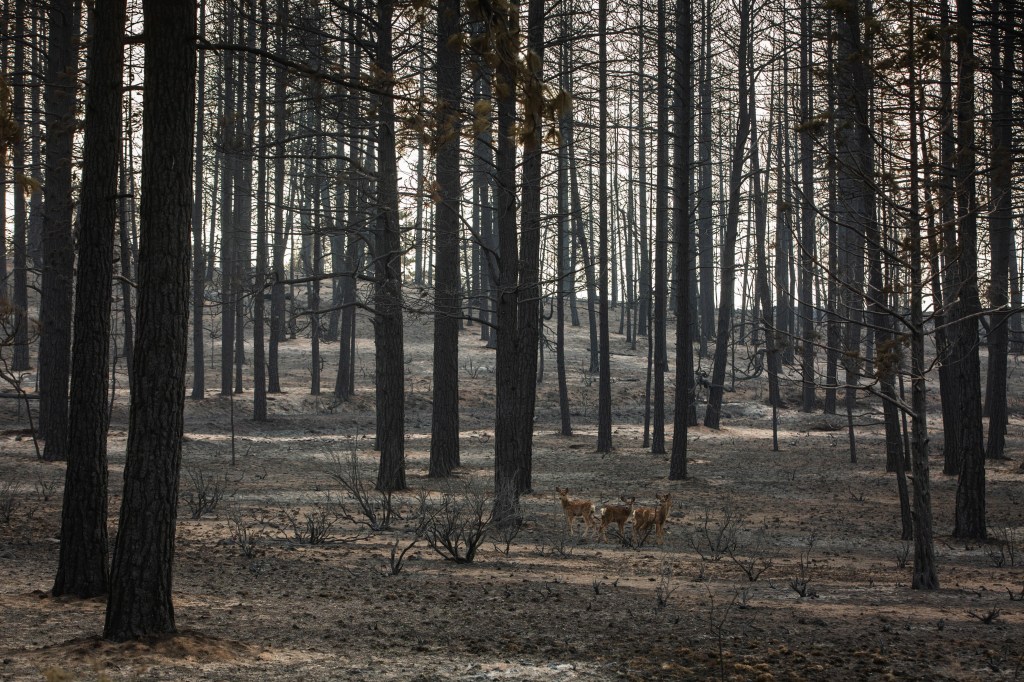California’s carbon offset program dedicated to preserving carbon-capturing forests to store CO2 is “dangerously undercapitalized” with 95 percent of the buffer planned for 100 years of wildfires depleted after less than a decade, a new study warns.
The peer-reviewed paper, published by researchers from the non-profit CarbonPlan on Friday in the peer-reviewed journal Frontiers in Forests and Global Change, raises significant and possibly existential concerns about the merits of carbon offset programs, specifically ones that pay landowners to preserve forests because of the carbon-harvesting properties of trees. The theory behind such programs is that by paying people or companies to protect trees that would otherwise be cut down, carbon is stored in the trees, offsetting a predetermined amount of CO2 emissions elsewhere.
Videos by VICE
It sounds simple, but in reality, forest-based offset programs are incredibly complicated to administer, involving lots of deep math to ensure offsets are being calculated properly. It requires the credits to go towards forests that would otherwise have been cut down, which does not always happen. For example, California’s program paid the Massachusetts Audubon Society $6 million not to cut down the trees on land it owns, which the conservation group likely never would have done in the first place.
Many factors to tree survival are largely outside the control of the parties who receive the credits—trees die for other reasons, like wildfires, disease, droughts, or insect infestations. To protect against these inevitabilities, California’s offset program has what’s called a buffer account of credits into which a percentage of each purchase goes. This account, according to the California Air Resources Board (CARB) which manages the program, “serves as an insurance mechanism to compensate for involuntary reversals (e.g., tree carbon stock loss due to wildfire, disease, or pest outbreak).”
But the new study contends the buffer account is not nearly large enough to make up for the devastating wildfires and disease affecting trees in the offset program’s portfolio. Typically, projects must contribute between two and four percent of the carbon credit purchases towards wildfire risks into the buffer account, or even less if it engages in wildfire management practices. When a wildfire happens in a credited forest, the credit owners have two years to report it and CARB will deduct those credits from the buffer account.
Since 2017, CARB has “retired”—to use the technical term—1.1 million credits out of about 31 million, due to “unintentional reversals,” the bureaucratic way of saying a forest that was supposed to last another 100 years and be a part of the climate solution instead burned down, releasing its CO2 into the atmosphere. About 20 percent of the 31 million credits (6.2 million) are earmarked for wildfire risks, while the rest are for disease, insect infestations, or bankruptcy and other financial risks from the forest managers themselves.
But the researchers, using data from four recent wildfires affecting carbon capture forests for which CARB has not yet retired any credits, say the remaining 5 million or so credits earmarked for wildfire risks are dangerously undercapitalized. Specifically, they estimate 95 percent of those credits, which were supposed to last for 100 years, have already been exhausted.
Even more troublingly, researchers say that the forest offset program is under serious risk even if they assume no more wildfires will happen (even though researchers expect wildfires to accelerate in frequency and severity due to the impacts of climate change). This is because the effect of a single disease, sudden oak death, may be large enough to “fully encumber the total credits set aside for all disease and insect related mortality over 100 years,” the study says.
“We knew the fires were big—everyone breathing the air or watching the news knew that,” one of the researchers, Danny Cullenward, told Motherboard via email. “We were surprised to find out that a single disease could have a similar scale of impact, even if over a longer time horizon.”
A spokesperson for CARB told Motherboard that the fact that the buffer is growing and being used as “evidence that it is a prudent part of our program.” The spokesperson added that CARB “developed the risk metrics that determine the buffer account contribution based on the best information available to us at the time we adopted the Protocol” and that it will “assess all relevant science and new information when we conduct our next protocol update.” The protocol has been updated twice since the introduction of the program but the spokesperson said it has “no timing to share” on when the next update may occur.
CARB has previously argued that as long as the program grows over time, future credits will make up for unexpected shortfalls, although Cullenward says this only works as long as risk levels go down over time. In fact, research continuously points to the exact opposite, that forests are at greater risk from wildfires and disease in the coming decades. He likened this approach to “putting old debt on a new credit card.”
The upshot of all this, Cullenward said, is that the buffer account is an insurance program, and “you know you have a problem when the liabilities that are coming are bigger than what you’ve prepared for; you don’t wait for an insurance company to go bankrupt before you start worrying about the protections its offering.”
The study echoes profound questions not just about CARB’s forest CO2 capture projects, but all forest carbon storage. “At the end of the day, I think it’s a mistake to rely on forest carbon storage to justify or ‘offset’ fossil CO2 emissions,” Cullenward said. “Forest and fossil carbon just aren’t comparable in climate terms, and no amount of fancy math is ever going to change that.”




